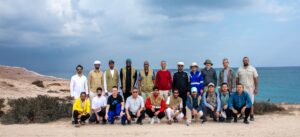Site visit to United Arab Emirates island
IGS senior specialist geoscientist Dr. Christoph J. Dobmeier took part in a pre-tender site visit on one of the islands of the United Arab Emirates in the Persian Gulf from December 11 to 13. 2024.
The round to elliptical shape of many of the islands gives a direct indication of their geology, as they expose parts of salt-piercement structures. All associated rocks of these structures form the Ediacaran to early Cambrian Hormuz Complex. A characteristic feature is the presence of megaclasts which can reach several 100 m in edge length. Current U-Pb ages indicate that the megaclasts (volcanic, subvolcanic, volcanogenic and detrital sedimentary lithologies) were not detached from younger units as the salt moved toward the surface. Since the ages match that of the salt, they must have been located directly underneath, above, next to or in between it.
The megaclasts are embedded in the so-called Hormuz breccia, a commonly poorly sorted breccia with a very fine-grained maroon matrix composed of gypsum (and/or anhydrite), quartz, and haematite. A slight salty taste indicates the presence of some halite. The almost complete absence of salt, however, was not expected and therefore a very big surprise. It is best explained by salt dissolution during arid weathering. The widespread occurrence of gypcrete (or gypcrust) supports this assumption. Sedimentary rocks of the Holocene Jebal Dhanna Formation rim the salt structure. While the salt structures were emplaced in Miocene time, the displacement of the Holocene rocks suggests that the salt is still or again moving.
IGS would like to thank the UAE Ministry of Energy and Infrastructure (MOEI) and Sharjah Environment and Protected Areas Authority (EPAA) for the invitation and their hospitality during the visit.

Participants of the site visit including IGS senior specialist geoscientist Dr Christoph J Dobmeier (standing, 3rd from right)
(For more information please contact us at enquiries@igsint.com)

